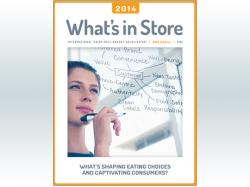What's In Store 2014 State Of The Industry Highlights
January 9, 2014 | 4 min to read

Madison, WI — What’s in Store 2014, the latest edition of the annual trends publication of the International Dairy-Deli-Bakery Association™ (IDDBA), and What’s in Store Online, a collection of more than 150 downloadable tables, as well as white papers and trends articles, are now available. With 28 years of credible reporting, What’s in Store is an essential dairy-deli-bakery-cheese resource providing vital data on the growth, trends, and category changes shaping the food industry. What’s in Store 2014 is composed of six comprehensive chapters: State of the Industry, Consumer Lifestyles, Bakery, Cheese, Dairy, and Deli.
Digital platforms will be used more to market and build relationships with shoppers. Personalization of promotions and offers will grow into a trend of “de-averaging,” or moving away from the trend of stocking shelves for the “average” customer, according to Jon Hauptman, Willard Bishop. De-averaging has the potential to improve efficiency of business models by catering stores and inventories to serve only the known product demand for their patrons. To maximize the potential of providing shopper solutions, brand manufacturers and retailers must collaborate more seamlessly in both digital and physical store levels.[i]
Seventy-three percent of top global retailers offer the same promotions online as in the store, only 16% offer the same prices online as they do in the store. Though 43% of consumers expected a retailer to offer the same products online as they do in the store, just 19% of retailers live up to that expectation. Accenture said that showrooming and webrooming are here to stay. Seventy-three percent of respondents said they engaged in showrooming — checking products and prices in the store before buying online — in the six months prior to the survey, but 88% said they participated in webrooming, or browsing first on the internet, then buying in-store.[ii]
Retailers will also capitalize on smartphone proliferation with time-saving shopping apps and geo-fencing ad strategies. Geo-fencing sets up a digital boundary that alerts stores when a shopper is nearby or in the store, automatically sending them advertising like deals and coupons. A Forrester Research survey found 37% of consumers engage in showrooming when buying groceries. Retailers can add value to their store in this new era of pricing transparency ensuring they’re charging fair prices for packaged goods, as well as raising the bar for in-store service, and providing store brands that allow for customer savings.[iii]
Keith Anderson, vice president and senior analyst, RetailNet Group, said retailers are implementing social media to extend the capabilities of their brick-and-mortar businesses. Social media, though not likely a portal to purchase food online, is helping shoppers gain access to apps to compile shopping lists and plan meals. Marketing and promotions are available in the same format, Anderson said. The mobile and digital food shopping experience is connecting shoppers with information that adds to transparency as many shoppers, particularly younger ones, want more information on where food originates and nutritional content. Promotions that traditionally communicated to consumers through inserts, as well as coupons, are moving to a digital format, which allows for personalization and ad targeting, Anderson said.[iv]
According to Sharon Olson, executive director, Culinary Visions Panel, younger consumers buy food from the standpoints of ethics, sustainability, simplicity, activism, and transparency. Ethical foods carry a social justice aspect that ensures proper treatment of the producers and animals involved via ethical certifications. Sustainability is worth paying a premium, despite the tough economy. Simple foods with few ingredients, grown locally and hyperlocally (on site) as well as prepared foods that tell the story of the foods’ relationships to the consumer, are all important to Gen Y, Olson explained. Food activism, including an ongoing international push against food waste, is another area of importance to younger consumers. Olson reported that Millennials seek out transparency.[v]
What’s in Store 2014, our 28th edition, is a 230-page trends report that details consumer and industry trends affecting the in-store dairy case, cheese case, bakery, deli, and foodservice departments. Its 200+ tables, developed in cooperation with leading industry firms and associations, include department sales, per capita consumption, consumer preferences, system 2, UPC, and private label sales data. The purchase of What’s in Store 2014 includes access to What’s in Store Online, a collection of downloadable tables from the book, plus white papers and trends articles (many with accompanying downloadable tables) that offer supplementary in-depth trends information. Be sure to save time using our Reference Links—these are web homepage links to all of the businesses referenced in What's in Store 2014. The cost is $99 for IDDBA members and $399 for non-members, plus shipping and handling. For more information and to order, visit iddba.org/wis.aspx.
About IDDBA: IDDBA is a nonprofit membership organization serving the dairy, deli, bakery, cheese, and supermarket foodservice industries. Member companies enjoy many benefits and services including the annual seminar and expo, leading-edge research, training programs, management tools, and an annual trends report. We will celebrate 50 years of service in 2014. For more information, contact IDDBA at 608.310.5000 or visit our website, www.iddba.org.
i] Brick Meets Click. “Anticipating the Future of Shopper Marketing: A Guide to What’s Next.” December 2012.
[ii] Accenture. April 2013.
[iii] Willard Bishop. “’Don’t Look Back:’ 10 Trends for 2013.” January 2013.
[iv] The Shelby Report of the Southeast. December 2012.
[v] Deli Business. October/November 2012.
Source: International Dairy-Deli-Bakery Association™ (IDDBA)
